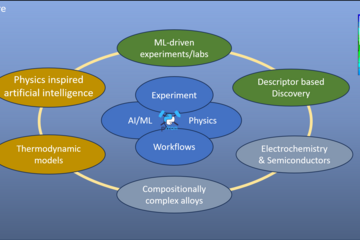All genres
11361.
Thesis - PhD
Dynamic correlations and confinement effects in glass forming hard sphere systems. Dissertation, RWTH Aachen, Aachen, Germany (2014)
11362.
Thesis - PhD
Molecular Dynamics Studies of Thermodynamical Consistency and Non-locality of Effective Temperature. Dissertation, Aachen Institute for Advanced Study in Computational Engineering Science (AICES), RWTH Aachen University, Aachen, Germany (2014)
11363.
Thesis - PhD
The inheritance of different microstructures found after hot rolling on the properties of a completely annealed dual phase steel. Dissertation, Fakultät für Georessourcen und Materialtechnik, RWTH Aachen, Aachen, Germany (2014)
11364.
Thesis - PhD
Multiscale description of super-saturated ferrite in severely deformed pearlitic wires. Dissertation, Ruhr-Universität Bochum, Bochum, Germany (2014)
11365.
Thesis - PhD
Feasibility study on local elastic strain measurements with an EBSD pattern cross correlation method in elastic-plastically deforming material. Dissertation, RWTH Aachen, Aachen, Germany (2014)
11366.
Thesis - PhD
Investigation of interface properties of barrier metals on dielectric substrates. Dissertation, Department of Physical Metallurgy and Materials Testing, Montanuniversität Leoben, Franz-Josef Strasse 18, 8700, Leoben, Austria (2014)
11367.
Thesis - PhD
Lithiation and delithiation mechanisms of model anodes for lithium ion batteries using the example of Au thin films: Correlation of electrochemical and in-situ high energy X-ray diffraction characterization. Dissertation, Fakultät für Chemie und Biochemie, Ruhr-Universität Bochum, Bochum, Germany (2014)
11368.
Thesis - PhD
Plasticity and fatigue of miniaturized Cu structures. Dissertation, Department of Physical Metallurgy and Materials Testing, Montanuniversität Leoben, Franz-Josef Strasse 18, 8700, Leoben, Austria (2014)
11369.
Thesis - PhD
Co-deformation of Amorphous CuZr/Nanocrystalline Cu Multilayers. Dissertation, Fakultät für Maschinenbau, Ruhr-Universität Bochum, Bochum, Germany (2014)
11370.
Thesis - PhD
Characterization and simulation of bainite transformation in high carbon bearing steel 100Cr6. Dissertation, RWTH Aachen, Aachen, Germany (2014)
11371.
Thesis - PhD
Fe–Mn–Pd maraging steels for biodegradable implant applications. Dissertation, Materials Science, ETH Zurich, Zürich, Switzerland (2014)
11372.
Thesis - PhD
Combinatorial screening of fuel cell catalysts for the oxygen reduction reaction. Dissertation, Fakultät für Chemie und Biochemie, Ruhr-Universität Bochum, Bochum, Germany (2014)
11373.
Thesis - PhD
Design and implementation of an automated electrochemical flow system coupled with mass spectrometry for investigation of the dissolution behavior of platinum. Dissertation, Fakultät für Chemie und Biochemie, Ruhr-Universität Bochum, Bochum, Germany (2014)
11374.
Thesis - PhD
Atomic scale investigation of clustering and nanocrystallization in FeSiNbB(Cu) soft magnetic amorphous alloys. Dissertation, RWTH-Aachen, Aachen, Germany (2014)
11375.
Thesis - PhD
Structure-property-relations of cuticular photonic crystals evolved by different beetle groups (Insecta, Coleoptera). Dissertation, RWTH-Aachen, Aachen, Germany (2014)
11376.
Thesis - PhD
Ultrathin Chemisorbed Polymer Coatings: Corrosion Protection and Nanostructuring of ZnO. Dissertation, Faculty of Chemistry and Biochemistry, Ruhr University Bochum, Bochum, Germany (2014)
11377.
Thesis - PhD
Degradation phenomena and design principles for stable and active Pt/C fuel cell catalysts. Dissertation, Fakultät für Chemie und Biochemie, Ruhr-Universität Bochum, Bochum, Germany (2013)
11378.
Thesis - PhD
Element resolved corrosion analysis of stainless steel-type glass forming steels and the correlation to their microstructure. Dissertation, Ruhr-Universität Bochum, Bochum, Germany (2013)
11379.
Thesis - PhD
On the role of dislocation transport in the constitutive description of crystal plasticity. Dissertation, RWTH Aachen, Aachen, Germany (2013)
11380.
Thesis - PhD
Pulsed Plasma Nitriding - Effect on Hydrogen Embrittlement and Hydrogen Adsorption and Diffusion. Dissertation, Norwegian University of Science and Technology NTNU, Trondheim, Norway (2013)


